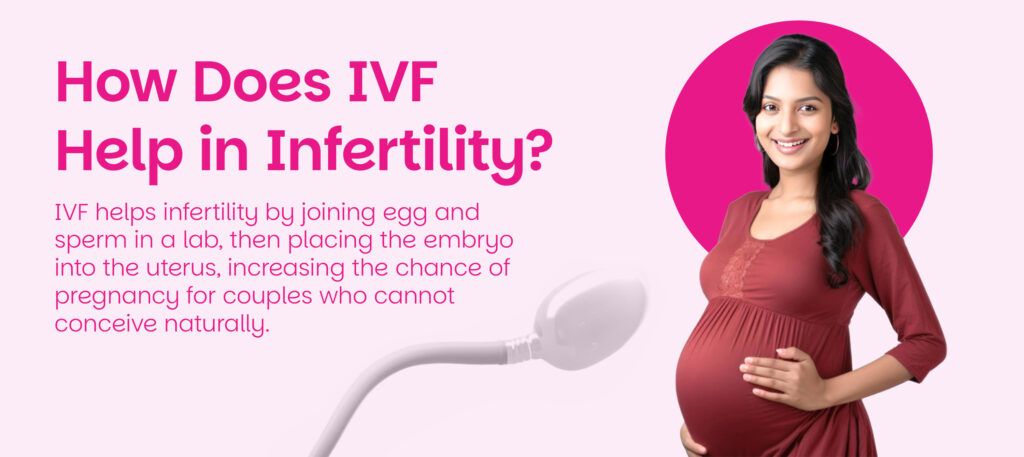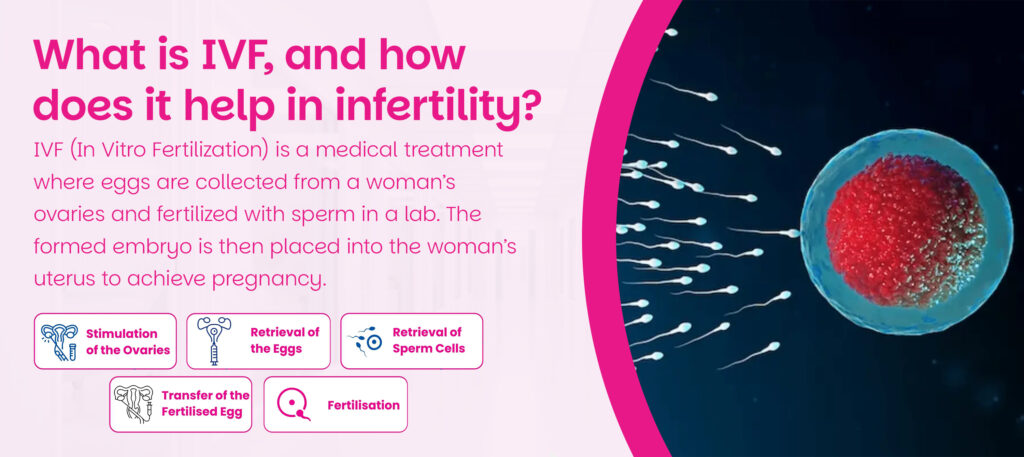Infertility can be one of the most challenging journeys a couple faces. For many, the inability to conceive naturally brings emotional distress, financial strain, and uncertainty about the future. Thankfully, medical science has advanced tremendously, and today, fertility treatments like IVF (In Vitro Fertilization) have given millions of couples around the world the joy of parenthood.
But what exactly is IVF? How does it work? And why is it considered one of the most effective infertility treatments? Let’s break it down step by step.
Understanding Infertility
Before we dive into IVF, it’s important to understand infertility itself.
Infertility is defined as the inability to conceive after 12 months of regular, unprotected intercourse (or 6 months if the woman is over 35).
It affects both men and women equally.
Common causes of infertility in women:
- Blocked or damaged fallopian tubes
- Ovulation disorders (like PCOS)
- Endometriosis
- Age-related decline in fertility
- Hormonal imbalances
Common causes of infertility in men:
- Low sperm count
- Poor sperm motility (movement)
- Abnormal sperm shape
- Genetic issues
- Lifestyle factors (smoking, alcohol, stress, obesity)
In some cases, infertility remains unexplained, which means no obvious cause is identified even after medical evaluation.
When simpler treatments like ovulation induction or IUI (Intrauterine Insemination) don’t work, couples are often advised to consider IVF treatment.
What is IVF?
IVF (In Vitro Fertilization) is a type of assisted reproductive technology (ART) where fertilization happens outside the human body, in an IVF laboratory.
Here’s a simple explanation:
Instead of waiting for the egg and sperm to meet naturally inside the fallopian tube, IVF helps them meet in a controlled lab environment. Once an embryo forms, it is transferred into the woman’s uterus to develop into a pregnancy.
IVF was first successfully used in 1978, and since then, it has brought millions of healthy babies into the world.
Step-by-Step Process of IVF
The IVF journey is usually divided into several stages:
1. Ovarian Stimulation
- The woman is given fertility medications (injections) to stimulate her ovaries to produce multiple mature eggs.
- This increases the chances of fertilization and pregnancy since more eggs are available.
- Regular monitoring is done through blood tests and ultrasounds.
2. Egg Retrieval (Ovum Pick-Up)
- Once the eggs are mature, they are collected using a minor surgical procedure under light anesthesia.
- A fine needle is used to aspirate eggs from the ovaries.
3. Sperm Collection
- The male partner provides a semen sample.
- If sperm count is low, advanced techniques like ICSI (Intracytoplasmic Sperm Injection) can be used, where a single healthy sperm is directly injected into an egg.
4. Fertilization in the Lab
- The eggs and sperm are combined in the embryology lab under controlled conditions.
- Fertilization is checked after 16–18 hours.
5. Embryo Culture
- The fertilized eggs (now embryos) are cultured in the lab for 3–5 days.
- Embryologists monitor their growth closely to select the healthiest embryos.
6. Embryo Transfer
In IVF, one or two embryos are carefully transferred into the uterus through a simple, ultrasound-guided procedure.
This is usually painless and does not require anesthesia.
7. Pregnancy Test
About 12–14 days after the transfer, a blood test is done to confirm pregnancy.
How Does IVF Help in Infertility?

IVF is considered one of the most effective infertility treatments because it bypasses several obstacles that prevent natural conception.
Here’s how it helps:
1. Overcomes Blocked or Damaged Fallopian Tubes
If a woman’s fallopian tubes are blocked, natural fertilization cannot happen. IVF allows fertilization outside the body, making the fallopian tubes redundant for conception.
2. Helps in Male Factor Infertility
Men with low sperm count, poor motility, or abnormal sperm can still become fathers through IVF combined with ICSI.
3. Addresses Ovulation Disorders
For women with irregular ovulation (like PCOS), IVF provides controlled egg stimulation and retrieval.
4. Useful for Unexplained Infertility
Even when no clear reason is found, IVF can help couples conceive by bypassing natural barriers.
5. Genetic Screening Before Pregnancy
Through advanced testing like PGT-A (Preimplantation Genetic Testing for Aneuploidy), embryos can be screened for chromosomal abnormalities before transfer, reducing miscarriage risks and increasing chances of a healthy baby.
6. Option for Donor Eggs, Sperm, or Surrogacy
For couples who cannot use their own eggs, sperm, or uterus, IVF allows the use of donors or surrogates to achieve pregnancy.
IVF Success Rates
IVF success depends on several factors, mainly:
- Age of the woman (younger women usually have higher success)
- Cause of infertility
- Embryo quality
- Doctor and lab expertise
At the best IVF centres, success rates are higher due to advanced labs, genetic testing, and personalized care.
Risks and Considerations in IVF
While IVF is safe, it does carry some risks:
- Ovarian Hyperstimulation Syndrome (OHSS)
- Multiple pregnancies (if more than one embryo is transferred)
- Emotional stress and anxiety during treatment
- Financial burden (IVF can cost ₹1,00,000–₹2,50,000 per cycle in India)
A good fertility centre ensures that risks are minimized through advanced protocols and supportive care.
Why Choose Vrinda Fertility for IVF Treatment?
At Vrinda Fertility, we provide world-class IVF treatment with a combination of medical expertise, advanced embryology labs, and compassionate support.
What makes us stand out?
- Experienced fertility specialists with 25+ years of expertise
- Cutting-edge lab technology (ICSI, genetic testing, time-lapse monitoring)
- High success rates across age groups
- Transparent pricing with no hidden charges
- Emotional and nutritional support for patients
We believe IVF is not just a medical procedure—it’s a journey, and we stand by your side every step of the way.
Conclusion
Infertility may feel overwhelming, but with the right medical support, parenthood is possible. IVF (In Vitro Fertilization) has transformed the lives of millions of couples worldwide, offering hope where natural conception was not possible.
If you’re struggling to conceive and wondering whether IVF could be the right choice, now is the time to consult an expert. At Vrinda Fertility, we provide ethical, advanced, and personalized IVF treatment to help you achieve your dream of becoming parents. Connect with us on Facebook, Instagram, for updates, guidance, and support.
Disclaimer: This guide is for educational purposes and does not substitute individual medical advice. Always consult your Vrinda Fertility specialist and a registered dietitian for tailored planning.
Frequently Asked Questions (FAQ)
IVF (In Vitro Fertilization) is an assisted reproductive technology where eggs are fertilized with sperm outside the body in a laboratory. Once embryos develop, they are transferred into the uterus to establish a pregnancy.
IVF is recommended for couples with blocked fallopian tubes, male infertility issues, ovulation disorders, endometriosis, unexplained infertility, or those who haven’t conceived after IUI or other treatments.
IVF bypasses barriers like blocked tubes, poor sperm quality, irregular ovulation, or unexplained infertility. It also allows for advanced genetic screening and use of donor eggs, sperm, or surrogacy when needed.
The IVF journey includes ovarian stimulation, egg retrieval, sperm collection, fertilization in the lab, embryo culture, embryo transfer, and finally a pregnancy test.
Most IVF procedures, such as egg retrieval and embryo transfer, are minimally invasive and performed under anesthesia or mild sedation. Patients may feel mild discomfort, but IVF is generally not painful.
IVF success depends on age, fertility health, embryo quality, and the expertise of the fertility centre. On average, success rates are:
40–50% for women under 35
30–40% for women aged 35–37
20–25% for women over 40
Yes. With advanced techniques like ICSI (Intracytoplasmic Sperm Injection), even men with low sperm count or poor motility can father a child through IVF.
Potential risks include ovarian hyperstimulation syndrome (OHSS), multiple pregnancies, emotional stress, and financial costs. However, modern IVF protocols minimize these risks.
Some couples achieve pregnancy in the first cycle, while others may need multiple attempts depending on age, embryo quality, and underlying fertility issues.
Yes. IVF is a safe and well-established procedure worldwide. Babies born through IVF are healthy, and risks are similar to those in natural pregnancies.



